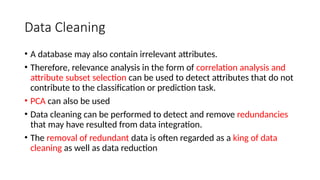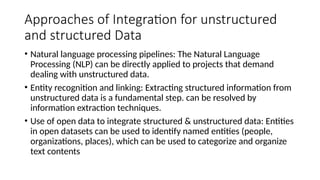Ad
Hetrogeneous Data handling in Big Data Analysis
- 1. Heterogeneous Data in Big Data
- 2. Heterogeneous Data • Heterogeneous data are any data with high variability of data types and formats. They are possibly ambiguous and low quality due to missing values, high data redundancy, and untruthfulness.
- 3. Why Data from Source is Heterogeneous • Firstly, the variety of data acquisition devices, the acquired data are also different in types with heterogeneity. • Second, they are at a large-scale. Massive data acquisition equipment is used and distributed, not only the currently acquired data, but also the historical data within a certain time frame should be stored. • Third, there is a strong correlation between time and space. • Fourth, effective data accounts for only a small portion of the big data. A great quantity of noises may be collected during the acquisitio
- 4. types of data heterogeneity • Syntactic heterogeneity occurs when two data sources are not expressed in the same language. • Conceptual heterogeneity, also known as semantic heterogeneity or logical mismatch, denotes the differences in modelling the same domain of interest. • Terminological heterogeneity stands for variations in names when referring to the same entities from different data sources. • Semiotic heterogeneity, also known as pragmatic heterogeneity, stands for different interpretation of entities by people.
- 5. Data representation can be described at four levels • Level 1 is diverse raw data with different types and from different sources. • Level 2 is called ‘unified representation’. Heterogeneous data needs to be unified. This layer converts individual attributes into information in terms of ‘what-when-where’. • Level 3 is aggregation. Aggregation aids easy visualization and provides an intuitive query. • Level 4 is called ‘situation detection and representation’. The final step in situation detection is a classification operation that uses domain knowledge to assign an appropriate class to each cell.
- 6. Data Processing Methods for Heterogeneous Data • Data Cleaning • Data Integration • Data Reduction and Normalisation
- 7. Data Cleaning Data cleaning is a process to identify, incomplete, inaccurate or unreasonable data, and then to modify or delete such data for improving data quality. For example, the multisource and multimodal nature of healthcare data results in high complexity and noise problems.
- 8. Data Cleaning • A database may also contain irrelevant attributes. • Therefore, relevance analysis in the form of correlation analysis and attribute subset selection can be used to detect attributes that do not contribute to the classification or prediction task. • PCA can also be used • Data cleaning can be performed to detect and remove redundancies that may have resulted from data integration. • The removal of redundant data is often regarded as a king of data cleaning as well as data reduction
- 9. Data Integration • In the case of data integration or aggregation, datasets are matched and merged on the basis of shared variables and attributes. • Advanced data processing and analysis techniques allow to mix both structured and unstructured data for eliciting new insights; However, this requires “clean” data.
- 10. Data integration & Challenge • Data integration tools are evolving towards the unification of structured and unstructured data • It is often required to structure unstructured data and merge heterogeneous information sources and types into a unified data layer • Challenge: One of reasons is that unique identifiers between records of two different datasets often do not exist. Determining which data should be merged may not be clear at the outset.
- 11. Approaches of Integration for unstructured and structured Data • Natural language processing pipelines: The Natural Language Processing (NLP) can be directly applied to projects that demand dealing with unstructured data. • Entity recognition and linking: Extracting structured information from unstructured data is a fundamental step. can be resolved by information extraction techniques. • Use of open data to integrate structured & unstructured data: Entities in open datasets can be used to identify named entities (people, organizations, places), which can be used to categorize and organize text contents
- 12. Dimension Reduction and Data Normalization There are several reasons to reduce the dimensionality of the data: • First, high dimensional data impose computational challenges. • Second, high dimensionality might lead to poor generalization abilities of the learning algorithm. • Finally, dimensionality reduction can be used for finding meaningful structure of the data
- 13. Finding redudancy and Removal • To check a correlation matrix obtained by correlation analysis. • Factor analysis is a method for dimensionality reduction. • Factor Analysis can be used to reduce the number of variables and detect the structure in the relationships among variables. Therefore, Factor Analysis is often used as a structure detection or data reduction method. • PCA is useful when there is data on a large number of variables and possibly there is some redundancy in those variables.
- 14. Several ways in which PCA can help • Pre-processing: With PCA one can also whiten the representation, which rebalances the weights of the data to give better performance in some cases. • Modeling: PCA learns a representation that is sometimes used as an entire model, e.g., a prior distribution for new data. • Compression: PCA can be used to compress data, by replacing data with its low-dimensional representation.
- 15. Big Data gaps & Challenges
- 16. Paradox of Big Data • Identity Paradox: Big data seeks to identify, but it also threatens identity. • The transparency paradox :The small data inputs are aggregated to produce large datasets. This data collection happens invisibly. Big data promises to use this data to make the world more transparent; but its collection is invisible; • The power paradox — Big data sensors and big data pools are predominantly in the hands of powerful intermediary institutions, not ordinary people.
- 17. Solution of big data analytics • Data loading — Software has to be developed to load data from multiple and various data sources. The system needs to deal with corrupted records and need to provide monitoring services. • Data parsing — Most data sources provide data in a certain format that needs to be parsed into the Hadoop system. • Data analytics —A solution of big data analytics needs to support rapid iterations in order for data to be properly analyzed.
- 18. Big Data Analytics • descriptive analytics — involving the description and summarization of knowledge patterns; • predictive analytics — forecasting and statistical modelling to determine future possibilities; and • prescriptive analytics — helping analysts in decision-making by determining actions and assessing their impacts.
- 19. Big Data tools • There are some Big Data tools such as • Hive • Splunk • Tableau, • Talend • RapidMiner and • MarkLogic
- 20. Big Data compute platforms strategies: • Internal compute cluster. For long-term storage of unique or sensitive data, it often makes sense to create and maintain an Apache Hadoop cluster within the internal network of an organization. • External compute cluster. There is a trend across the IT industry to outsource elements of infrastructure to ‘utility computing’ service providers. • Hybrid compute cluster. A common hybrid option is to provision external compute cluster resources using services for on-demand Big Data analysis tasks and create a modest internal computer cluster for long-term data storage.
- 21. Outlier detection • The statistical approach, • The density-based local outlier approach, (Local Outlier Factor) • The distance-based approach, (Clustering) • The deviation-based approach (Deep Learning Based)
- 22. Traditional Data Mining and Machine Learning, Deep Learning and Big Data Analytics
- 23. Future Requirement for Big Data Technologies • Handle the growth of the Internet — As more users come online, Big Data technologies will need to handle larger volumes of data. • Real-time processing — Big Data processing was initially carried out in batches of historical data. In recent years, stream processing systems is developing, such as Apache Storm. • Process complex data types — Data such as graph data and possible other types of more complicated
- 24. Future Requirement… • Efficient indexing — Indexing is fundamental to the online lookup of data and is therefore essential in managing large collections of documents and their associated metadata. • Dynamic orchestration of services in multi-server and cloud contexts — Most platforms today are not suitable for the cloud and keeping data consistent between different data stores is challenging. • Concurrent data processing — Being able to process large quantities of data concurrently is very useful







































































